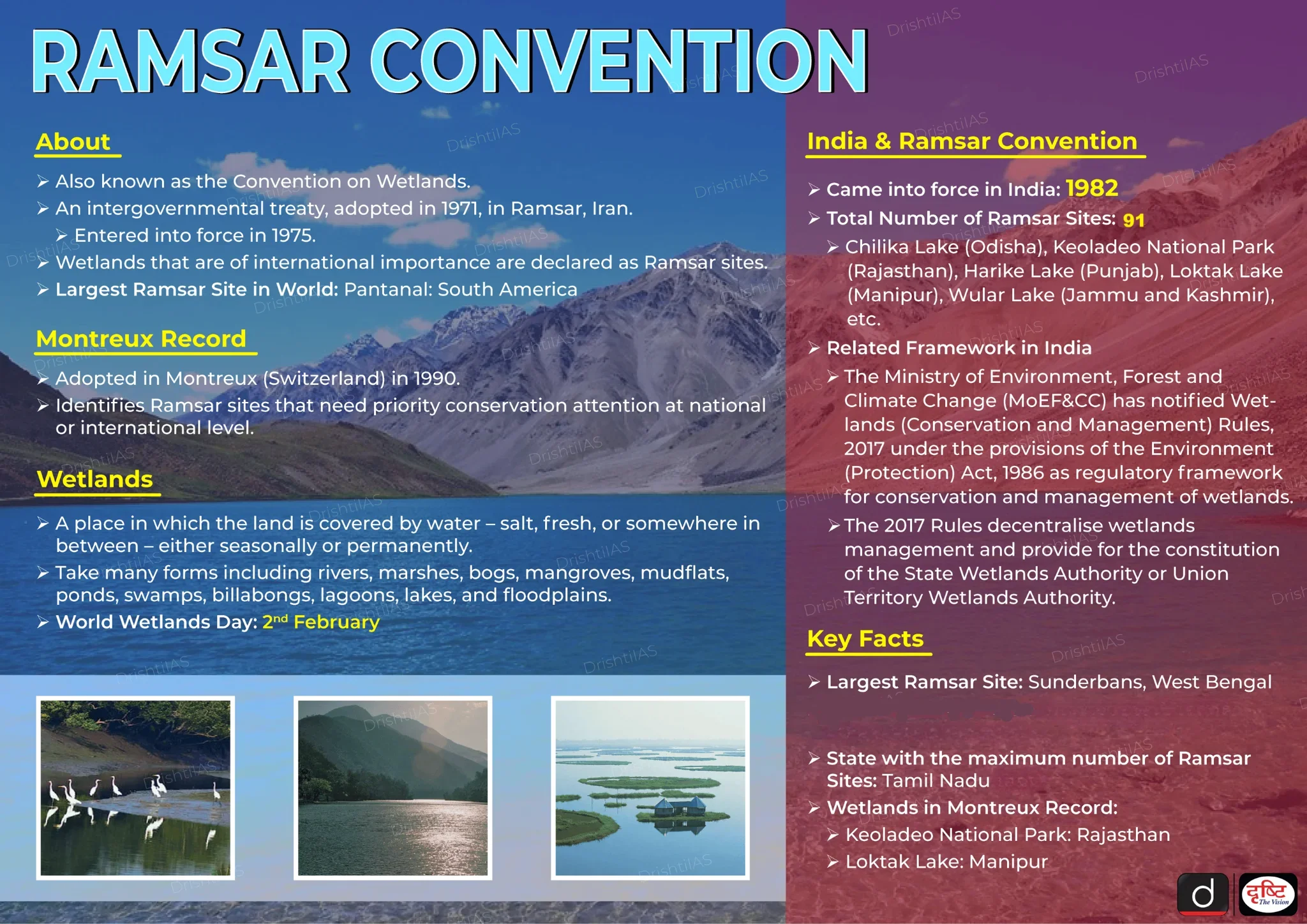Facts for UPSC Mains
India's Resolution on the 'Wise Use of Wetlands' Adopted at Ramsar COP15
- 02 Aug 2025
- 7 min read
Why in News?
India’s resolution on the ‘‘Promoting Sustainable Lifestyles for the Wise Use of Wetlands’’ was adopted at the 15th Conference of the Contracting Parties (COP15) to the Ramsar Convention on Wetlands, held at Victoria Falls, Zimbabwe.
What is India’s Resolution on the Wise Use of Wetlands?
- About: India’s resolution builds upon UN Environment Assembly Resolution 6/8 on ‘Promoting Sustainable Lifestyles’ adopted in 2024 and promotes a whole-of-society approach to wetlands conservation.
- Key Provisions:
- Alignment with Global Frameworks: India’s resolution aligns with Resolution XIV.8. It also supports the 10-Year Framework on Sustainable Consumption and Production (10YFP).
- Resolution XIV.8, adopted at the COP14 of the Ramsar Convention on Wetlands, outlines a "new CEPA approach", which focuses on Communication, Education, Participation, and Awareness (CEPA) for wetland conservation and wise use.
- 10YFP is a global framework adopted at the Rio+20 Conference in 2012 to accelerate the shift towards sustainable consumption and production (SCP) patterns.
- Integration of sustainability: Urges voluntary integration of sustainable lifestyle-based interventions into wetland plans, programmes, and investments.
- Mission LiFE Linkage: Builds on India’s Mission LiFE (Lifestyle for Environment), a movement for pro-planet behaviour, launched at UN Climate Change Conference in Glasgow (COP26).
- Behavioral Change Focus: Encourages conscious consumption, waste reduction, and actions that minimise environmental degradation.
- Alignment with Global Frameworks: India’s resolution aligns with Resolution XIV.8. It also supports the 10-Year Framework on Sustainable Consumption and Production (10YFP).
Wise Use of Wetlands
- The Ramsar Convention (1971) defines wise use of wetlands as “the maintenance of their ecological character, achieved through the implementation of ecosystem approaches, within the context of sustainable development”.
- India’s Approach to Wise Use: India released the “Wetland Wise Use – An Implementation Framework (2024)”, which aims to clarify the concept of wise use and provide a practical roadmap for achieving it across wetlands in the country.
- Under initiatives like Mission Sahbhagita and the Save Wetlands Campaign, over 2 million citizens have volunteered in the past three years, leading to the mapping of more than 1.7 lakh wetlands and boundary demarcation of nearly 1.2 lakh.
- Additionally, the National Plan for Conservation of Aquatic Ecosystems (NPCA) continues to guide restoration and sustainable management of aquatic ecosystems.
- The Amrit Dharohar Scheme supports wetlands through eco-tourism, community-based livelihoods, biodiversity conservation, and carbon storage.
What are the Key Outcomes of Ramsar COP15?
- Victoria Falls Declaration: It underscores the need for political commitment, increased resource mobilisation, and investment in wetland management.
- Adoption of 13 Resolutions: The parties also agreed to strengthen flyway conservation for migratory birds, establish the Global Waterbird Estimates Partnership, and protect species like river dolphins.
- Notably, a resolution on wetland restoration was adopted, urging the development of national policies for restoring degraded freshwater ecosystems.
- A resolution was adopted to refine criteria for designating Wetlands of International Importance, based on IUCN Red List data and input from IUCN Specialist Groups.
- Resolutions also recognised the role of indigenous knowledge and local communities in sustainable wetland management.
- 5th Ramsar Strategic Plan: Parties adopted the 5th Strategic Plan with 4 goals and 18 targets. The STRP (Scientific and Technical Review Panel) will monitor progress.
|
Drishti Mains Question: The concept of ‘wise use’ of wetlands is central to the Ramsar Convention. Examine India’s approach towards ensuring the wise use of wetlands. |
| Read more: Global Wetland Outlook 2025 |
UPSC Civil Services Examination Previous Year Question (PYQ)
Prelims
Q. “If rainforests and tropical forests are the lungs of the Earth, then surely wetlands function as its kidneys.” Which one of the following functions of wetlands best reflects the above statement? (2022)
a. The water cycle in wetlands involves surface runoff, subsoil percolation and evaporation.
b. Algae form the nutrient base upon which fish, crustaceans, molluscs, birds, reptiles and mammals thrive.
c. Wetlands play a vital role in maintaining sedimentation balance and Soil stabilization.
d. Aquatic plants absorb heavy metals and excess nutrients.
Ans: (d)
Q. If a wetland of international importance is brought under the ‘Montreux Record’, what does it imply?(2014)
(a) Changes in ecological character have occurred, are occurring or are likely to occur in the wetland as a result of human interference
(b) The country in which the wetland is located should enact a law to prohibit any human activity within five kilometres from the edge of the wetland
(c) The survival of the wetland depends on the cultural practices and traditions of certain communities living in its vicinity and therefore the cultural diversity therein should not be destroyed
(d) It is given the status of ‘World Heritage Site’
Ans: (a)
Mains
Q. What is wetland? Explain the Ramsar concept of ‘wise use’ in the context of wetland conservation.Cite two Examples of Ramsar site from India. (2018)







